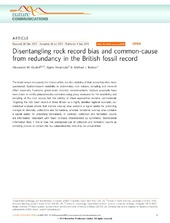Disentangling rock record bias and common-cause from redundancy in the British fossil record
| dc.contributor.author | Dunhill, Alexander M. | eng |
| dc.contributor.author | Hannisdal, Bjarte | eng |
| dc.contributor.author | Benton, Michael J. | eng |
| dc.date.accessioned | 2015-10-28T13:38:53Z | |
| dc.date.available | 2015-10-28T13:38:53Z | |
| dc.date.issued | 2014-09-04 | |
| dc.Published | Nature Communications 2014, 5 | eng |
| dc.identifier.issn | 2041-1723 | en_US |
| dc.identifier.uri | https://hdl.handle.net/1956/10609 | |
| dc.description.abstract | The fossil record documents the history of life, but the reliability of that record has often been questioned. Spatiotemporal variability in sedimentary rock volume, sampling and research effort especially frustrates global-scale diversity reconstructions. Various proposals have been made to rectify palaeodiversity estimates using proxy measures for the availability and sampling of the rock record, but the validity of these approaches remains controversial. Targeting the rich fossil record of Great Britain as a highly detailed regional exemplar, our statistical analysis shows that marine outcrop area contains a signal useful for predicting changes in diversity, collections and formations, whereas terrestrial outcrop area contains a signal useful for predicting formations. In contrast, collection and formation counts are information redundant with fossil richness, characterized by symmetric, bidirectional information flow. If this is true, the widespread use of collection and formation counts as sampling proxies to correct the raw palaeodiversity data may be unwarranted. | en_US |
| dc.language.iso | eng | eng |
| dc.publisher | Nature Publishing Group | en_US |
| dc.rights | This work is licensed under a Creative Commons Attribution 4.0 International License. The images or other third party material in this article are included in the article’s Creative Commons license, unless indicated otherwise in the credit line; if the material is not included under the Creative Commons license, users will need to obtain permission from the license holder to reproduce the material. | eng |
| dc.rights.uri | http://creativecommons.org/licenses/by/4.0/ | eng |
| dc.subject | Biological sciences | eng |
| dc.subject | Palaeontology | eng |
| dc.title | Disentangling rock record bias and common-cause from redundancy in the British fossil record | en_US |
| dc.type | Peer reviewed | |
| dc.type | Journal article | |
| dc.date.updated | 2015-03-26T13:21:35Z | |
| dc.description.version | publishedVersion | en_US |
| dc.rights.holder | Copyright 2014 Macmillan Publishers Limited. | en_US |
| dc.identifier.doi | https://doi.org/10.1038/ncomms5818 | |
| dc.identifier.cristin | 1204331 | |
| dc.subject.nsi | VDP::Matematikk og Naturvitenskap: 400::Zoologiske og botaniske fag: 480 | en_US |
Tilhørende fil(er)
Denne innførselen finnes i følgende samling(er)
-
Department of Earth Science [1050]
Med mindre annet er angitt, så er denne innførselen lisensiert som This work is licensed under a Creative Commons Attribution 4.0 International License. The images or other third party material in this article are included in the article’s Creative Commons license, unless indicated otherwise in the credit line; if the material is not included under the Creative Commons license, users will need to obtain permission from the license holder to reproduce the material.

